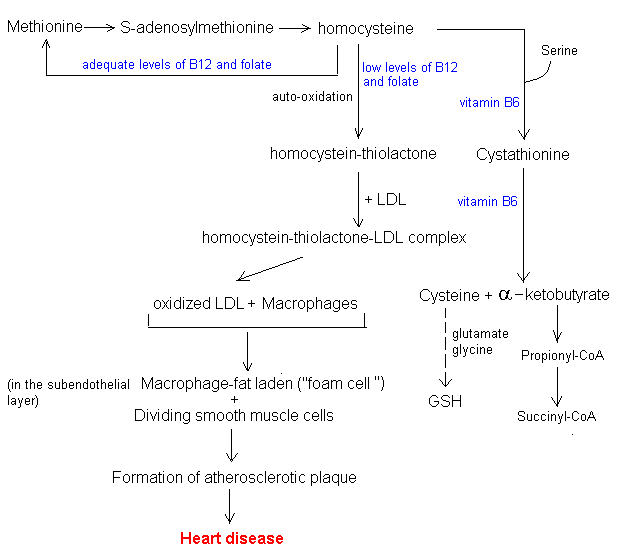|
The original hypothesis that implicates homocysteine in the etiology of atherosclerosis was put forward some 40 years ago by McCully (1) and a short overview on the subject was published recently (2). Many experts in this field accept now the idea that hyperhomocysteinemia could be a risk factor for the cardiovascular disease according to several possible mechanisms (3,4). Homocysteine autooxidizes relatively easy and turns into homocystein-thiolactone. This is a highly reactive compound that can form a complex with LDL that makes the lipoprotein more prone to oxidation. In the subendothelial space the oxidized LDL is taken up by the macrophages that become "foamy cells" because of the large amount of LDL accumulated within cells. They become entrapped in the subendothelial space and eventually desintegrate releasing a large amount of free radicals. The oxidative processes occurring in the sub-endothelial space lead to endothelial cells damage and the formation of the atherosclerotic plaque, which in most cases causes a stroke. If enough vitamin B6, B12 and folic acid are present in the body (5) the homocysteine is either converted back to methionine or catabolized to citric acid cycle compounds. In this way, the damaging effects caused by the oxidative reactions in which homocysteine plays a central role can be prevented. However, despite substantial progress in understanding the postulated role of homocysteine as a risk factor in atherogenesis that involves an oxidative stress mechanism it would appear that there is no conclusive evidence to support the homocysteine-induced oxidative stress mechanism. Along this line, in a recent paper Huerta and his associates have shown that in healthy elderly there was no lipid peroxidation associated with increased homocysteine plasma levels as determined by measuring plasma concentration of malone dialdehyde and the activity of two antioxidant enzymes, glutathione peroxidase and superoxide dismutase (6). Summing up, it appears that a clear answer regarding the involvement of homocysteine in atherogenesis through an oxidative stress-mediated mechanism is not forthcoming yet. 
References 1. McCully, K.S. (1969) Am.J.Pathol. 56, 111-128. Vascular pathology of homocysteinemia: implications for the pathogenesis of arteriosclerosis. 2. McCully, K.S. (2007) Am.J.Clin.Nutr. 86(suppl) 1563S-1568S. Homocysteine, vitamins, and vascular disease prevention. 3. Durand, P. et al. (2001) Lab.Investig. 81, 645-672. Impaired homocysteine metabolism and atherothrombotic disease. 4. Loscalzo, J. (1996) J.Clin.Investig. 98, 5-7. The oxidant stress of hyperhomocysteinemia. 5. Ward, M.(2001) Int.J.Vitam.Nutr.Res. 71(3) 173-178. Homocysteine, folate and cardiovascular disease. 6. Huerta, J.M. et al. (2004) Free Rad.Res. 38, 1215-1221. No evidence for oxidative stress as a mechanism of action of hyperhomocysteinemia in humans. |
